
The following is part of Now Loading, a series that renders verdicts on whether or not your favorite video games deserve a place in the canon of works that have contributed to video-game storytelling in landmark ways. Read the series’ full mission statement here.
I Can’t Keep Explaining to You How Devastating Toxic Fandoms Can be to a Legitimately Great Game So I Won’t Even Try
Ladies and gentlemen, boys and…more boys? Huh. We seem to be a little off-ratio this week, but that’s fine. I’m a professional, and, despite hating change, I will grit my teeth and power through it. Welcome to Now Loading…The Video Game Canon! The weekly Internet column in which we take a fair, balanced, critical look at video games from the past to determine whether or not we should discuss them in the future. It’s been a pretty wild ride so far, and I can’t imagine the wild levels will be toning down with this week’s candidate. I have this theory, you see, when it comes to explosively popular games and the fandoms that sprout up around them like so many nerdy weeds. The world is rife with amazing games, but only a select few develop a fanbase willing to slice open their palms and pledge blood allegiances to show their intense loyalty towards the property.
Isn’t that strange? I find it strange.
Take our last candidate, The Legend of Dragoon, for example. There’s a pretty evident cult following behind that game, but I doubt that many of those fans would choose the Melbu Frahma Hill to be the one they die on. No, no: there are fandoms, and then there are super, hyper fandoms that marinate in their own visceral, pulsating fanatic juices until they reach a level of such ardent, blinding love for something, unrivalled in intensity by even the purest example of true love.
Fans belonging to these hyper plunge deep into the world of the game, exploring every nook and cranny, every pixel of every screen, every note of every song, every meaning of every different word to construct a conception of the game that could very well serve as a full biography for that portion of their life. We’re talking Five Nights at Freddy’s; we’re talking League of Legends; but, most importantly, we’re talking about Toby Fox’s magnum opus, Undertale.
I remember the before-time, when “sans” and “papyrus” were just names of fonts that no one ever used. It was a simpler era of gaming, when Toby Fox was not yet the mad genius auteur on the level of George Lucas, but rather a humble video game developer making Halloween Hacks of Earthbound and Homestuck homages. Birds still sang, the moon was not yet the color of sack-cloth, and the now-awakened Elder Ones yet slumbered ‘neath the calm oceans of the world. I think we all remember where we were when Undertale was first released…Myself, I was tending to my rose garden as my wife played make-believe with my three beautiful sons. Of course I felt the chill of the grave rush down my spine, but I was still naïve enough to believe it to be a gust of wind, not the end of all things. Sometimes, late at night, when the fourteen different arrangements of “Bonetrousle” blaring outside my hovel fall into what I can only describe as a merciful lull, I can still hear my boys playing with my wife. I can still hear their voices… “Daddy,” they asked, watching the DOW Jones crumble beneath the sheer weight of excess fan art, “what’s a Pappy-Roos?”
I can hear them still.
All right, to be fair, I’m adding just a pinch of hyperbole to the fandom that developed around this game, but for those of you who have had any experience with the vehement fans of Undertale, you no doubt remember how you just couldn’t escape from this game when it was first released. Even to this day it has a massive fanbase that, if they don’t like what I have to say in this piece, will likely try to find me and string me up by my thumbs for devilish blaspheming. And, listen, for all the many jokes I make about the fandom for this game, the crazy thing is that I completely understand how people are diehard fans of Undertale.
Because Undertale is really good. A masterpiece, in fact. Love or hate the fandom, the game is a brilliant commentary on the state of video games and the people who play them, and I can only posit that the reason so many people would go to war for this game is because they were so heavily and deeply affected by the story and themes presented in this creative little title. I will never claim to have an understanding of blindingly passionate fandoms, but it is certainly something that we will explore in the following sections as we decide whether or not Undertale should be inducted into the canon of video games. So make some spaghetti and get determined, because here we go.

Oh, and I don’t want to make a habit of saying this because I believe you need to examine an entire game before effectively commenting on it, but SPOILERS AHEAD. I’m going to be talking about story points from this game that I really think you should experience on your own, if you haven’t already. All right, boys and boys, you’ve been forewarned.
Story and Characters: A True Testament to Brilliant Writing
There’s a reason I dwelled on the fandom for this game so heavily in the introductory section, and it’s not because I’m out to make fun of it or belittle it. Like I said, I understand why Undertale is so beloved, and I believe it is because of all the many ideas that are present in this game, the one theme that links them all together: obsession. In a sort of ouroboros scenario, Undertale has amassed such diehard fans because the very heart of the game is centered on fanaticism that tends towards obsession. Not only is every character in the game obsessed with something specific to their character, but the player herself is called out for—and at times even shamed for—the obsession they have with playing a game to completion. Never before have I played a game that openly punishes you for wanting to experience all that it has to offer, and in that way Undertale is an excellent commentary on that little spark in gamers—dare I call it, determination—that leads us to restart a video game over and over and over again just to see all the different possible endings and beat all the secret bosses.
But, hey, I’m getting ahead of myself here. I don’t want to get too heavily into the themes just yet, but just do me a favor and keep in mind that through line of obsession in this game, all right, bucko?
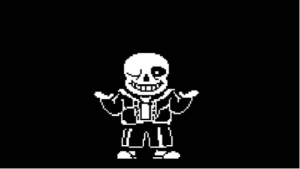
The story, for all its many branching pathways, is a fairly simple one at heart. Where the complexity and truly wonderful storytelling comes in is with the characters, but we’ll examine them in a moment. So, what is the story of Undertale? Long ago, before the events of the game, humans and monsters lived on the surface together in peace. However, because it became alarmingly clear that humans are inherently stronger than monsters due to the strength of their souls relative to their beastly cohabitants, the humans got greedy and waged a massive war against the monsters, ultimately ending the fight by sealing every monster away underground beneath a giant mountain. The monsters are unable to leave the Underground, but every now and again a human will climb to the top of the mountain and tumble, Alice-in-Wonderland style, down to the mysterious world of the monsters.
This is where our avatar, an androgynous mute child, enters the story. The child, to whom I will refer with ‘she/her/hers’ for ease, falls into the Underground and is met by an overprotective mother figure named Toriel who guides her through the ruins. Not wanting to stay in the Underground forever, our avatar escapes the ruins and continues on in her adventures through the Underground. She meets a colorful cast of monsters along the way, and eventually learns that the only way to break the seal keeping the monsters locked away is to either merge a human soul with a monster’s soul, or collect seven human souls, absorb their power, and blast your way through it. The player and avatar opt for the former option, and wind their way through the Underground until they face off against Asgore, the king of all monsters.
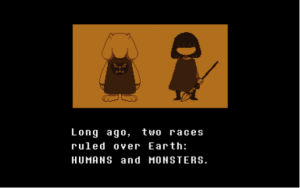
Having never played the game or heard anything about it, you may think that it’s fairly simple based on that little description of the story. However, the story gets somewhat complicated somewhat quickly, depending on how you choose to play the game. There are effectively three main paths which you can take as you progress through the game:
- You can either be a total pacifist, choosing not to kill any of the monsters or bosses
- You can go through the game neutrally killing a few people here and there and fighting against the bosses
- You can choose to literally seek out and kill every monster and every boss in a branch lovingly referred to as the “genocide run.” What a fun, happy time for everyone!
Choosing the neutral path (#2) will result in the game ending somewhat unfinished, with certain extra pathways being cut off to you based on whom you’ve killed and what you’ve done in the game up until the ending. However, the pacifist run (#1) and genocide run (#3) both change the outcome of the story dramatically.
If you choose the pacifist path, then you are given a bit more insight into what happened in the Underground before your arrival. It turns out that you are by no means the first human to have taken a tumble down the mountain, and that the very first kid who did that was taken in by Asgore and Toriel, and treated as their adopted child. That child became best friends with their biological son, Asriel, and for a shining moment in the Underground, there was peace and happiness. However, the human child fell deathly ill one day, and wished only to see the flowers from her hometown one last time. Unable to break through the barrier to bring her home, she died in Asriel’s arms, which resulted in her soul fusing with the young prince’s body, making him nearly indestructible. With this newfound power, he broke through the barrier and carried his adopted sibling’s lifeless body back to her village. Seeing this terrifying monster holding a dead child, the villagers rashly assumed that Asriel had killed the child. They launched an all-out attack on Asriel, but he did not even defend himself. Bloodied and broken, he crawled back to the Underground where he died on a bed of flowers… Asgore and Toriel had lost both their children.
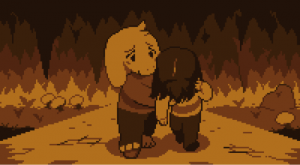
The death of the two royal children led to disarray and panic in the Underground, and, in a moment of rash decision-making, Asgore proclaimed that he would do everything in his power to collect seven human hearts, break through the barrier, and wage total war against the humans on the surface. This proclamation brought hope back to the denizens of the Underground, and Asgore was, to his dismay, bound to his word to carry out the merciless execution of any human who would fall to his kingdom. Full of grief and unable to abide by Asgore’s new stance on humans, Toriel left her husband and retreated back to the ruins in hopes that she could keep any fallen humans from the horrible fate that now awaited them in the Underground.
But her plans fell through time and again, because eventually Asgore collected six human souls and was just one shy of being able to burst through the barrier and enact his people’s vengeance. Enter our avatar, who, in the pacifist run befriends all the different characters that she meets, helping them achieve their goals as her own adventure unfolds. The bonds she makes with them engender in the monsters a new, stronger hope: that maybe one day, instead of waging war on the humans, they can actually coexist once more. That’s the hopeful outlook, anyway.
Once all is said and done in the story, the monsters realize that you are not who they thought you were the entire time, and that they’ve been calling you the name of that first fallen human because of how similar you look to her. You inform them that your name is Frisk, and that you were simply another kid who fell into their world and wanted to get back home. The pacifist run ends on a very happy note, with all the monsters reaching the surface and looking onwards toward the sun, and to the happy future that it promises.
If you have enough sadism in you to kill each and every monster in the game, eventually the goal of the other characters in the Underground shifts from trying to return to the surface to simply stopping your insane parade of violence. It is revealed through a number of different battles with boss characters that you are actually some gut-wrenchingly terrible reincarnation of that first fallen human, whose name we discover to be Chara, and that, through the events which transpired on the surface with Asriel, you have become some twisted version of yourself, hell-bent on ending all life in the world. It’s a pretty bleak ending, especially if you’ve played through the game at least once and gotten to know and love the characters, only to see them beg for mercy from you later.
There is so much more to say about this game and its compelling story, but I will leave it at that brief explanation of the lore and impart one insight to you before insisting that you play the game for yourself. Notice that both the pacifist and genocide versions of Undertale ask you to follow some very specific, very powerful guidelines. Namely, you must be either merciful to every single monster you encounter or brutally kill them, respectively. In order to complete either route of the game, you must devote a certain amount of obsession to these goals. It is so easy in a pacifist run to get frustrated on a boss and resort to violence, and it is equally easy in a genocide run of the game to be convinced by the begging of the characters to simply show them a little mercy. In order to complete either of these versions of the game, you must be obsessed—or, in the game’s terms, determined—to stick it out on the path that you have chosen. It stops being about simply beating the game or enjoying the story, and instead becomes a challenge to play the game in a very specific way. Undertale enters into a contract with the player that assumes a predilection towards obsession, and it tells a much deeper story for it.
Now let us shy away from the story for a while and take a closer look at our cast of characters. I have already given a bit of information about the avatar and her relationship to the established characters Frisk and Chara, so I will not say much more about her. Instead, let’s take a look at this lovable bunch of monsters and what they obsess over, so that we can get a better idea of who we surround ourselves with while playing Undertale.
For ease, let’s run down the list of the main characters in order of appearance in the game. Also, since most of the characterization takes place in the pacifist version of the game, assume that these character descriptions are taken from that run. After you wake up from your fall, the first monster you run into is the deceptive, maniacal, sentient flower, appropriately named Flowey. Flowey introduces himself to you as a denizen of the underground, and attempts to educate you in the ways of conversation and combat in this new world you’ve found. He seems to be quite a friendly fellow at first, but after tricking you (or trying to trick you, as the case may be) into getting hurt during a battle, Flowey reveals his true nature as a truly horrifying monster who imparts to you his motto—“Down here it’s kill or be killed”—before trying to murder you indiscriminately. Toriel saves you before any further harm can befall you, however, and the story progresses. Flowey is later revealed to be the twisted shadow of Asriel, and, in the pacifist run of the game, he absorbs the soul of every single monster in the underground, effectively becoming a god with total control over time and space. Of course, if you continue in the vein of pacifism that led you to the fight with him, he eventually relents to your mercy and reverts back to his true form: the scared little kid who just wanted to save his friend.
Flowey—and, by extension, Asriel—is consumed by his hatred of all living things, which began when he was mercilessly slaughtered by humans while trying to return his friend’s body to her home. The obsession here, then, is to relive the events of the game over and over in an effort to maximize his pleasure in killing everything. In this way, Flowey is not only a great villain for the game, but also a great counterpart to the player in that he also wants to explore every possible outcome just to see what happens. He even goes so far as to taunt the player, saying that he and the player are just the same, and that, given the chance and power that he receives, the player would do the same thing as him. And if the player chooses to perform a total genocide run of the game, then Asriel’s assertion was absolutely true. “And you know what the best part is?” he asks during your fight with him, “You’ll do it.”

‘Eyyyyyyyyyy, I’m nuts!
Then we have Toriel, a loving mother figure who is tortured by the loss of her children, and determined not to let the same thing happen again. She is incredibly protective of your fallen human avatar from the start, literally holding her hand through puzzles and over-explaining every little thing to make sure you don’t get hurt. Once you make it clear that you would like to leave her house and try to get back to the surface, she tries to stop you by destroying the exit to the ruins. She engages you in a fight, and, depending on which run you are performing, you can either show her mercy to the point that she realizes she can’t stifle you with her protection, or you can brutally kill her, causing her to realize that you’re not in danger—you are the danger.
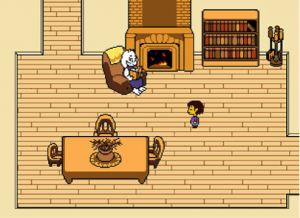
I am, on occasion, perhaps even the one who knocks.
It comes through fairly obviously that Toriel is overprotective of you for a reason, and when the story of Asriel and Chara’s deaths is told to the player, it immediately becomes clear that she is obsessed with that loss, and feels immense guilt for not being able to protect her children. After Asgore decreed that the monsters would wage an all-out war with the surface, she retreated to the place where that first human fell to her, becoming a recluse who spends her days writing bad jokes, reading about snails, and baking for the child who she hopes so fervently will come home to her. She is by all accounts the kindest person you encounter in the Underground, and it becomes quickly apparent that her kindness stems from a deep grief that she cannot shake.
Next up, we meet everyone’s favorite skeletal twins, Sans and Papyrus. As you leave the ruins, you walk through a forest towards the town of Snowdin, only to realize that you are being followed. Once you reach a footbridge leading into the town proper, a shadowy figure pats you on the back and offers to shake your hand. The slow deflation of a whoopee cushion introduces us to the humor and general candor of Sans the Skeleton, one of the two skeleton brothers who make their home in Snowdin. Sans, we quickly realize, has some strange powers that lead us to believe he is more than he seems. He is able to get a read on you pretty quickly, offering something of a judgment call on you based on whether or not you killed Toriel and the other monsters of the ruins. Sans is a lazy jokester, and, while he may not take his job as a human-hunting sentry all too seriously, he makes it clear that he’s keeping his eye on you, watching your every move and evaluating just how dangerous you might be to the Underground.
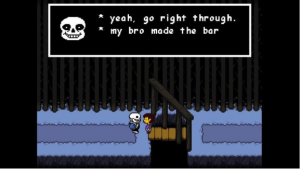
Papyrus, Sans’s bombastic brother, is the more serious of the pair. He is hilariously egocentric, and yet it is clear through his dialogue and actions that he’s really just looking for some good friends. He thinks pretty highly of himself, but as you get to know him more over the course of the game, you realize that his attitude is based less in cocky egotism, and more in pure, healthy self-esteem. Papyrus may be a bit full of himself, but his confidence and perseverance stem from a genuine work ethic and desire to help the monsters of the Underground. The best way he imagines he can help people is to catch a human, join the royal guard, and assist monster-kind in getting back to the surface.
Had Undertale had poorer writing, Papyrus’ obsession with catching a human would have been his singular goal. Yet when you show him a little affection and treat him like a friend, he immediately warms up to you and tries to help you in your quest to go home. The drive behind his actions, you come to realize, is that he just wants to have friends and help people. Likewise, even though Sans has some vague motives depending on which path you pursue, he makes it clear that he truly loves and admires his brother, and that he wants to help him be happy any way he can. Whether this is using his space-time powers to work five jobs at once so that they can afford to pay the bills and let Papyrus chase his dream, putting together some (admittedly weak) puzzles, or simply encouraging his brother, we see that Sans is driven by affection for his brother. When people discuss Undertale, they tend to assume that there is some weird subtext with these two characters, making claims that they are more insidious than they appear at first glance. And while I agree that Sans certainly has more knowledge about the world than he lets on, I really think these two numbskulls are just two brothers trying to support each other.
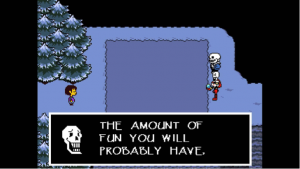
…IS FAIRLY SUBSTANTIAL! NYEH!
Next we meet Undyne, the fish-faced leader of the royal guard and perpetual tutor to Papyrus. Undyne is perhaps the best example of the obsession theme in the game, as her singular purpose is to catch a human and get her fellow monsters back onto the surface. She is motivated by her respect for Asgore, and truly believes in the edict he made that all humans are out to get all monsters. As such, she naturally has no trust for the avatar, and is the only boss in the game that you literally have to run away from—otherwise, the fight will continue ad infinitum. She is determined to bring your soul to Asgore and help him in his quest to return to the surface, and only after saving a monster kid in front of her does she begin to come around to the thought that you, a human, are not trying to murder indiscriminately. Of course, that’s in the pacifist run. She pretty much has your number from her first appearance if you’ve been working the genocide angle instead. Some stereotypes are true depending on which choices you make, it seems.
After meeting Undyne, we meet Dr. Alphys, the royal scientist in charge of investigating and experimenting with both human and monster souls in order to understand this mysterious power called “Determination,” which allows humans to persist after death. That’s her title, anyway, and while she does end up performing some horrid experiments on the monsters of the Underground that result in a number of sputtering horrors called “amalgamates,” she doesn’t ever really seem to embody the mad scientist archetype. Instead, she is a very anxious, nerdy person who is a diehard fan of two things: an anime from the human world, and Undyne. Alphys is incredibly smart, but she’s limited by her own social anxiety, as we see time and time again with her interactions with the avatar and the other characters. Eventually, she overcomes her embarrassment and reveals her feelings to Undyne, who, in a speech that speaks to the positive side of obsession and fandom, tells Alphys that she likes her back because of how passionate she is in everything she does. Undyne, after all, is driven solely by her passionate hatred of humans and her obsession to capture them, and so it stands to reason that the thing she admires and respects above all else is unbridled passion in a person. Alphys, though timid in most situations, truly shines when discussing her work or the anime that she loves, and it’s in the moments when she reveals her true personality when Undyne feels closest to her.
I could go into all the different side characters—like the dog guards or Napstablook, the ghost with no confidence (a personal favorite of mine)—but, in the interest of brevity, I will close out by talking about who I consider to be the strongest character in the game: Asgore.
Similarly to how Ganondorf is built up in Ocarina of Time as a menacing figure to scare you before your encounter with him, as you progress through the Underground, you hear many different stories about Asgore to prepare you for what you must face before returning to the surface. Unlike Ganondorf, however, Asgore is never really portrayed as menacing or terrifying. Quite the contrary, in fact. Through reading the history of the Underground and talking to people who have known him the longest, you slowly piece together a picture of a kind, albeit sort of silly, ruler who has never lost the respect of the people over whom he rules. He, Toriel, and Asriel were all truly beloved by the monsters, and, before the death of the fallen human, the monsters generally felt that they didn’t really need to go back to the surface. Life was good, and the royal family provided for the people very well.
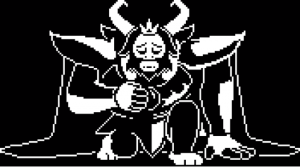
Even when Asgore’s family broke apart, the people of the Underground suffered with him through his loss. They lost hope for happiness, and, seeing this despair amidst his people, Asgore made a promise that he by no means wanted to make. Though we know he decreed that all humans must be captured and eventually put to death, this is a leader who loved a human like his own child. When you meet him at the end of the game, you and he both know that one must kill the other for the barrier to be broken, yet there is a palpable sense that he does not want to do it. There is not a mean bone in his body; he actually stops himself from offering you tea before the big fight, because he knows how hard it would be to do what he promised if he were to grow attached to this child like he did before. He lost his family once, and to relive the death of a human again and again, even for the liberation of his people, has taken a noticeable toll on him.
What’s so heartbreaking about Asgore is that, while he is obsessed with breaking the barrier and protecting his people, you can tell that it’s something of a necessary obsession, and the fact that he is effectively the final boss places him in a role that cannot allow for mercy, as he demonstrates by literally destroying the “Mercy” option in his fight. Even if you were truly pacifist, he changes the battle so that you must fight him. But why would he bother destroying the option of mercy if he were dead-set on killing you? Why would he not just let you use merciful options, making it that much easier for him to kill you as a passive participant in the fight?
Well, the fact that he destroys that mercy option is not to make the fight harder, but to make the choice to kill him easier. More tantalizing. He destroys the mercy option not because he will not show you mercy, but rather because he does not believe he deserves any.
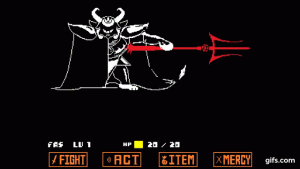
The saddest dad.
Well this is shaping up to be the longest canon piece yet! In fairness, I think the story and characters are perhaps the strongest part of the game, largely due to the brilliance with which the characters are written and presented as you progress through the story. If it’s not clear by my lengthy descriptions, this section has earned the game a point for canon entry.
Gameplay, Music, and Visuals: This May be the Easiest Section I’ve Ever Had to Write
In contrast to the last section, this one will be relatively quick, namely because I have nothing bad to say about Undertale’s gameplay, music, and visuals. We’ve loosely been over the choice system that dictates which run of the game you perform, but let’s briefly go over how those choices are presented to you in the first place. The game is set up as your basic JRPG at first glance, with turn-based combat against many and varied monsters, each with their own unique abilities and personalities. However, unlike a traditional JRPG where the enemy monsters would simply attack you back or cast a spell on you, the enemy’s turns in the game take the form of bullet-hell mini games, in which you need to dodge various objects being thrown at you by the enemies.
The game’s battle system is an amazing hybrid of old-school JRPG conventions and bullet-hell games, and is only made more interesting when you explore the different options you have in battle. You can fight, of course, in which you have to succeed at a sort of quick-time, button-press event to deal more damage, but you also have the choice to “Act” or engage in “Mercy.” The “Act” option functions in different specific ways as you face different monsters, and runs the gamut between complimenting someone on his hat to paying off a greedy spider woman in exchange for her attack being lessened. If you act correctly and choose the right options for each monster, you can choose to “spare” the monster with the “Mercy” button. By doing this, you can still technically win the battle and get some spoils without ever killing anything.
Before the final fight with Asgore, Sans approaches you in a rather elaborate church hallway to judge you for the sins you have committed over the course of the game. These are represented by two values, EXP and LOVE respectively. In any other game, these would be representative of experience points and your level, but not in Undertale. In this game, Sans explains to you, EXP stands for “Execution Points,” and LOVE stands for “Level of Violence.” The more Execution Points you have, the greater your Level of Violence becomes, and so both of these values indicate how many monsters you have killed in the game.
If you’ve done a neutral run of the game, Sans will lightly shame you for having killed a few monsters here and there, but unless one of those monsters was Papyrus, he kind of cuts you some slack, saying basically that “you did what you had to do, I get it.” However, if you manage to get to Sans having killed no monsters and amassing no EXP, he will laud you for your peaceful nature, affirming to the player that there is no situation in Undertale that would necessitate the use of violence. Conversely, if you go through the entire game purposefully seeking out each monster in order to brutally murder them, Sans takes it upon himself to unleash his full fury upon you so that you can’t inflict any more harm on the Underground or the surface. Needless to say, Sans is the hardest boss in the game. If you would like to read more about that, stay tuned for the Bonus Level section, below. You’re gonna have a bad time.
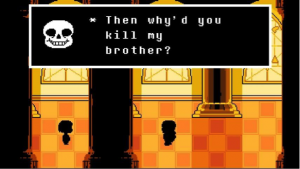
*pretty spooky, huh?
So Undertale’s gameplay is interesting, innovative, and nuanced, such that it really serves the story while also providing the player with a fun experience. Battles are exciting and fun to engage in, and the puzzle that is figuring out how to spare monsters engages the player in ways that traditional, turn-based role-playing games don’t.
What really adds to the fights, in my opinion, is the brilliant soundtrack that accompanies this game. All tracks were composed by Undertale creator, Toby Fox, and are so wonderfully representative of the characters and situations in the game. There are just over one-hundred tracks in the game, and each one does a perfect job of setting the mood, whether they be the backing tracks of different towns, the toe-tapping, random-encounter theme, or the amazing boss and character themes, which are just dripping with personality. The only way I could praise the music of Undertale more would be if I somehow had the option to initiate certain themes to be played in my everyday life. Until technology for playing ubiquitous music in situations that do not call for it leaves my fanciful head and becomes reality, I will just stick to saying that the game’s music is incredible.
And, lastly, the visuals are at once reminiscent of games like Earthbound and other NES/SNES era games, and also a unique style all their own. It has what I would refer to as Tim Burton creepy cuteness: you’re surrounded by monsters in a creepy underground world, and yet every character is so charming and interesting to look at that you can’t help but hope to befriend all of them. There are only a few environments in the game, but each one has such unique ambiance and character that they are instantly recognizable and memorable. I would posit, too, that the themes for each of the areas in the game greatly contribute to how fun and memorable they are—but then, there I go, praising Undertale’s soundtrack again.
In summation, I can count the issues I have with this game’s gameplay, music, and visuals on one hand. I could do with fewer of the non-Toby-Fox-inspired drawings, because things like the Temmie characters feel sort of incongruous with the rest of the Underground to me. Despite all its denizens being monsters, there are certain designs that just stick out as not quite being a part of the world at large. Apart from that, I cannot come up with many more problems that aren’t incredibly nitpicky. You get another point for the canon, Undertale.
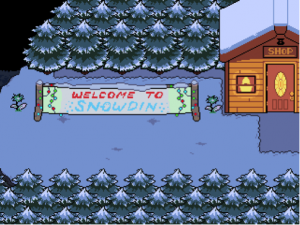
Goodness me, I do feel welcome!
Impact on Gaming and Culture: Back to the Fandom
If you are a human being living on this, the planet of Earth, and you have at least a passing interest in video games and video game culture, I would be willing to wager my house and at least someone else’s apartment that you have heard of, if not played, Undertale. With the recent release of this game on the Playstation Network nearly two years after its initial PC release, it is clear that there is still a massive amount of interest in this game and what it has to offer. A simple YouTube search will net you a nearly infinite supply of fan animations, remixes of the soundtrack, and videos critically analyzing every aspect of the game in order to better glean its lessons and mysteries. Whether you like this game or not, it’s hard to deny that it’s had a pretty sizable impact on gaming culture.
Undertale is popular, and it doesn’t seem to be going anywhere anytime soon. With that, we come back to the question that I posed in the introduction of this article: Why? Why is the fandom for this game so passionate? We’ve looked at the story, the characters, and the gameplay itself, and it’s pretty evident that it is a well-written and beautifully put-together game. Yet, there are plenty of video games with all those same traits that don’t even come close to speaking to people on the emotional level that Undertale does.
Well, to get to the heart of this question, I think it would be wise to look at a facet of video games that we talk about here on the site a lot: the fact that video games are an interactive medium. We toss around the term “immersion” pretty frequently when discussing video games, but, really, any video game worth its salt is going to be able to suck you in just a little bit. It takes a very specific set of circumstances, however, to draw you in so forcefully that you feel an intense emotional, perhaps even spiritual, connection to the events and characters of a game. So, how does Undertale differentiate itself from other “immersive” video games?
First, you are playing as a silent protagonist with a very neutral, gender-ambiguous design. This is simple, but it is so very important when making a game that feels like your avatar is you. The fallen human character is a blank canvas whom you get to name, and it interacts with the world on your behalf without any question or commentary.
Second, the characters feel like real people. Yes, oddly in a game that is largely about monsters, the writing for each character is so rich and wonderful that the characters with which you interact have personalities that seem familiar to you. You can imagine meeting someone as driven as Papyrus, or someone as nervous as Alphys. Though they may be hyperbolic at times, they never feel as if they couldn’t be actual people; and, as easy as that sounds, there are an incredible amount of games with teams of thousands that just can’t write characters like humans.
Lastly, and I think most importantly, the game and its themes are constructed in such a way that it speaks to the nature of video gaming itself. This one’s a little more difficult to parse through, but bear with me, Dear Reader.
Like I’ve said from the beginning, I believe that ultimately Undertale is an exploration of obsession, and how obsession can benefit or harm you depending on how you use it. You are already drawn into the game by the blank canvas character, the promise of an interesting world to explore, and these strong characters we meet right off the bat; so, when the game starts throwing this idea of obsession at you with its dialogue and story beats, you are already a little obsessed with the game. You’ve bought into the hype, as it were, and are ready to fully engage with the game on its own terms. You become obsessed with your goal of getting to the surface, or helping your newfound friends, or killing them all, or whatever your playthrough may look like.
And when you consider this, it makes perfect sense that people have become so obsessed with this game. It’s a story about obsession, after all, and when you’ve completely given yourself over to a game that alternately applauds and demeans both the characters and the player for having curiosity and being obsessed with the game and its contents, why stop being obsessed with it when you’ve played through it once? Why not play through it a number of times to see what happens if you play it a different way? Why not buy the soundtrack and listen to it until your computer fries? Why not sit at a desk at your day job and write a nearly eight-thousand-word article about the game to publish on a site that discusses the merit of deeply analyzing the stories of games?
Why not?!
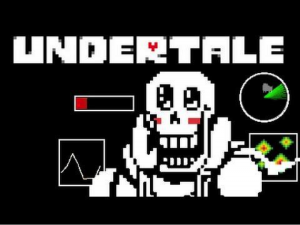
THIS GAME IS MEETING ALL OF MY STANDARDS!
BONUS LEVEL: What If…said Toby Fox, Menacingly
Ladies and gentlemen, boys and the callback joke, “BONUS LEVEL” is typically the part of these articles in which I take a closer look at a particular scene, piece of music, or aspect of gameplay so that, no matter my decision vis-a-vis canonization, the game in question is still allowed its moment in the sun. And frankly, up until this final draft, the Undertale article was going to be no different. I figured I would take a closer look at the fight with Sans during the Genocide run, and explain in excruciating detail just how wonderful the “Megalovania” battle tune is. And yet, in my obsession to grant this game the justice and praise I believe it deserves, I kept revisiting this particular BONUS LEVEL over and over again like so many infinite timelines, trying for literally hours to piece together my thoughts into a cogent, cohesive understanding of just what Undertale is trying to teach us through its brilliant writing, characterization, and exploration of obsession. And with each half-hearted paragraph I would write into existence, with each sentence I would type out and then frustratedly delete, with each word I would slave over and then berate myself for not expressing my thoughts perfectly, I slowly began to realize what was literally and figuratively driving me forward. I was driven by something that is deliberately stated in Undertale to be a trait solely belonging to humans, the one trait that makes any one human more powerful than all the denizens of the Underground combined: Determination.
Not only was I determined to construct the perfectly worded article that gave this brilliant game its due, but with every single phrase I poured onto the page, I was determining what I wanted to say about this game. And that simple realization put the entire game into perspective in a way that makes the themes of obsession that I have discussed at length above even more interesting in the context of the game’s story. Even a cursory glance at the characters in Undertale will show you that they all have a strong drive to accomplish the goals which they have set out for themselves. By all accounts, the monster characters in Undertale are just as determined as the player avatar, and yet it is explicitly stated time and time again that monsters lack Determination. They can have obsessions and passions, naturally, but that capital “D” Determination is reserved for humans and humans only.
In this way, “Determination” as Undertale describes it refers not to an inherent drive to see something through to its end, but rather to the ability to make decisions and literally determine the outcome of the game’s story. If we consider “monsters” to be non-player characters and “humans” to be player avatars, it is only natural that humans would be inherently stronger than monsters. After all, we players have the power to choose which path we take in the game, which of the characters we would like to kill or spare, and, ultimately, how we want the story to end. If I play through the game and decide that killing Papyrus makes me feel terrible, I can choose to turn back the clock to a previous save state and make the decision to save him. Based on the knowledge that I as a player have about the game’s story and its many possible outcomes, I have the power to determine how events unfold.
Now, if I were any run-of-the-mill, two-bit video game critic, I would end this BONUS LEVEL here, applauding Undertale for commenting on how, in video games, player agency is an important thing. And yet, Dear Reader, I am made of somewhat sterner stuff than that strawman I just constructed, so let’s take a look at how Undertale first acknowledges this determinative power that the player inherently has, and then turns that power on its head by asking one simple question: “What if the final boss had the same abilities as the player?” Dear Reader, let’s revisit our best friend, Flowey.
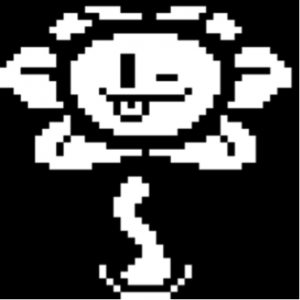
After you confront Asgore, Flowey returns to consume the human souls that have been collected in the Underground over the years. In a frightening display of his newfound power, he destroys your save file, menacingly informing you that there is no escape back to a point before he consumed the souls. By doing this, he has briefly stripped you of your determinative powers, disallowing you from going back to a point when you could have hoped to change things. Then, in a move of pure, sadistic pleasure, Flowey informs the player that he can now manipulate the game as he sees fit, and vows to save over your death so that he can revel in your pain over and over and over again. Drunk on his newfound power, Flowey then transforms into a gigantic, eldritch creature only Lovecraft himself could have conjured, and begins to deliver on the promise he made.
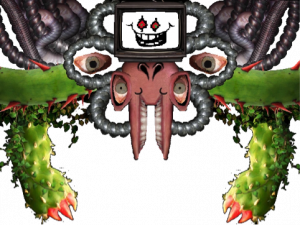
Oh. Neat.
The fight against this Determined Flowey is a bullet-hell sequence the likes of which you have not seen in the rest of the game. The screen is covered in all manner of projectiles that greatly damage you; when you inevitably die from Flowey’s unrepentant onslaught, your floral foe taunts you by saying you are living in a perpetual nightmare from which there is no waking, and then uses his newfound power of Determination to close the game window. When you reboot the game, you are met once again by Flowey’s mockery, and are launched back into the hellish fight, only for Flowey to save over your pain, reload it, and experience your humiliating loss over and over again. Only after rebooting the game a number of times and persisting through the battle are you able to turn the tide and hurt Flowey, but even when you lower his health to 0, he simply reloads one of his many save states in which he is back at full health, and begins the whole ordeal over again.
Determined Flowey’s actions are a mocking reflection of abilities available to the player. Just like a petulant player who won’t accept defeat against a standard RPG monster, he bombards you with overpowered attacks, takes pleasure in manipulating save states so that he can relish killing you ad nauseum, and resets the entire fight given the chance that he loses. The entire game up to this point has been full of the monster characters explaining just how powerful Determination is, but it isn’t until the tables are turned on the player, subverting the very conventions that are likely second-nature to someone familiar with video game mechanics, that the player understands just how frightening and helpless one feels when put on the receiving end of someone else’s unfettered decision-making. The reason Determined Flowey is so terrifying isn’t because of his ghoulish design, but rather because of his unmitigated, player-like control over you, making you feel like the non-player character. Like the monster.
Even if only for a moment.

Monsters? They look like monsters to you?
VERDICT: No Boondoggling For You
Undertale is one of those rare games that both exists on its own merits as a wonderful game and stands as a commentary on video games as a medium. For people who have been playing games their whole lives, as well as for someone who has never so much as touched a controller, this game is able to envelop the player in an amazing world filled with beautifully written characters and scenarios that make the player just as obsessed as the characters in the game. It’s no wonder that such a strong, unbreakable fandom arose around this game, and more power to them. Undertale is not just a game, but a story for the ages, and it has a well-earned spot in the Video Game Canon!
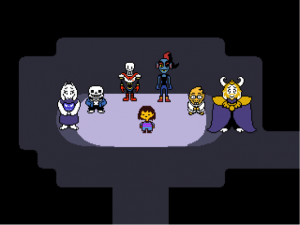
Well done, gang!


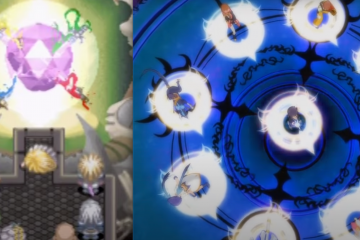

1 Comment
Luffy · June 12, 2018 at 7:12 am
Dan, what a fantastic post! That is such a detailed article about undertale. I appreciate the time and energy you put into your blog, thanks for the great great overview!